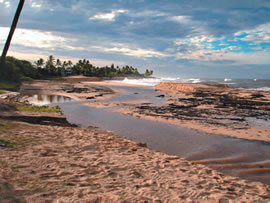Surfers Are Swallowing More Than Just Seawater

Wednesday - January 07, 2009
| Share
 Del.icio.us
Del.icio.us
|
Ask any surfer and he or she will tell you there’s nothing quite like swallowing a mouthful of the Pacific Ocean.
“It’s horrible,” says surfer Dane Wong with a look of disgust on his face. Wong laughs and continues, “Even if your mouth is shut, the ocean somehow finds a way in. It’s the worst!”
The truth is there is something worse, and it may change the way you think the next time you wax up your board.
A new study conducted by scientists at Oregon State University and the Oregon Department of Environmental Quality found that surfers may unintentionally ingest 10 times more water than swimmers or divers.
“I believe that, but so what?” asks Wong.
What’s the big deal? When you consider the bacteria levels at some of our beaches, especially near the mouths of streams following a sewage spill or big rainfall, you can understand why scientists say surfers are at a higher risk of contracting gastrointestinal illnesses.
“Our findings suggest that surfers who spend longer periods of time in recreational waters or who surf in more-contaminated locations are likely to be at higher risk of contracting gastrointestinal illnesses,” says David Stone, an assistant professor in the OSU Department of Environmental and Molecular Toxicology.
The Oregon State study is believed to be the first of its kind. Surfers estimated the amount of water they ingest during a surf session, selecting from a few drops, 1 to 3 teaspoons, the amount in a shotglass (1 to 2 ounces) or the amount of a juice glass (4 ounces).
Sixteen percent reported a few drops, 51 percent reported 1 to 3 teaspoons, 21 percent reported a shotglass, and less than 2 percent reported a juice glass. Scientists then calculated the risk of infection from fecal bacteria using enerococci as an indicator organism.
“Surfers should be aware that they are swallowing a fair amount of water. This is especially important when surfing after a big rainfall near outfalls or in other locations where the level of contamination may be higher,” says Stone.
“It’s not just after you ‘eat it,’” admits Wong. “We’ve all filled our mouths with water in between sets, and I’m sure I’ve swallowed water and didn’t know it. And then there are times when you absolutely know you’ve gulped down more than a glassful.”

|
The recent heavy rains and flooding on Oahu contributed to brown water advisories across the island. Pollutants from overloaded sewage systems also made their way into our ocean.
“It gets ugly out here after big storms,” adds surfer Kimi Okamoto, who surfs at Ala Moana, where the Ala Wai Canal empties into the ocean. “I can only imagine what’s in the ocean and potentially in all of us.”
The results of the Oregon State study could be useful to public health and environmental officials who are responsible for gathering samples at beaches and those who set advisory thresholds.
“On beaches popular with surfers, officials might want to consider lowering the advisory threshold because surfers ingest higher doses of water than swimmers,” says Anna Harding, a professor in the OSU Department of Public Health.
“Makes sense, but I’m not sure it will keep people out of the ocean if the conditions are right,” chuckles Wong. “Sharks don’t, why would bacteria?”
The results of the study certainly won’t keep most surfers out of the water, but it’s something to think about the next time you suffer a nasty wipe-out.
In fact, you may want to keep your mouth shut - literally. You could be swallowing more than a mouthful of water.
E-mail this story | Print this page | Comments (0) | Archive | RSS Comments (0) |
Most Recent Comment(s):













